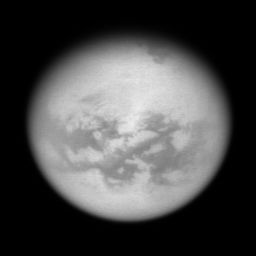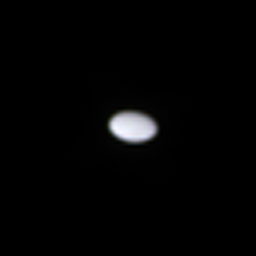Emily Lakdawalla • Feb 05, 2009
Vernal dawn is coming to Titan's far north
Spring is coming to Titan's northern hemisphere (as it is to all the rest of Saturn's moons, along with Saturn itself). Consequently, the cameras are finally getting enough light to take photos of the lakes near the north pole; until now, they've pretty much been shrouded in shadow, visible only to the active sensor system of the RADAR instrument. Thanks to Gordan Ugarkovic for the tip on this image.

NASA / JPL / SSI / Gordan Ugarkovic
Peeking into Titan's northern territory
Cassini captured some distant views of Titan on January 31, 2009. It is now close to the northern spring equinox in the Saturn system, so more and more of the extreme north of Saturn and its moons is illuminated with every passing day. Consequently, the cameras are finally obtaining unmistakable images of the dark outlines of the methane-ethane seas that Cassini's RADAR instrument has discovered in the extreme north, including the gigantic Kraken mare, visible at the top of this view.
NASA / JPL / SSI / Gordan Ugarkovic
Pallene
The best image Cassini took of Pallene throughout the primary mission reveals no features on the surface, which appears to be very smooth. This is a color view taken from a distance of 76,000 kilometers and a phase angle of 21 degrees on June 8, 2005. It has been magnified four times. The surface has a blue tint to it, like Telesto but unlike most of the other tiny moons located close to Saturn. Pallene and its neighbor Methone, both just a few kilometers in diameter, were discovered in Cassini images; they orbit between Mimas and Enceladus, outside the main ring system.The Time is Now.
As a Planetary Defender, you’re part of our mission to decrease the risk of Earth being hit by an asteroid or comet.
Donate Today

 Explore Worlds
Explore Worlds Find Life
Find Life Defend Earth
Defend Earth

